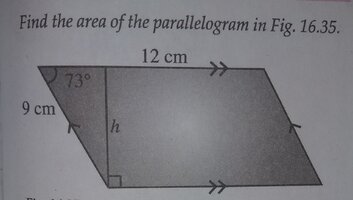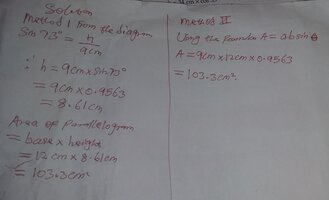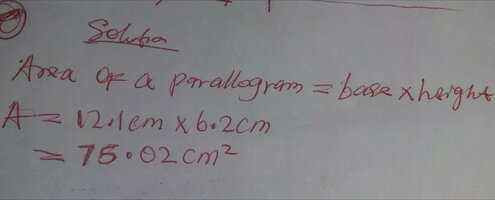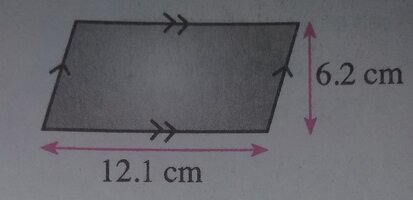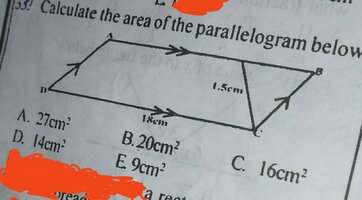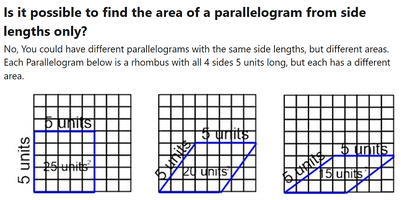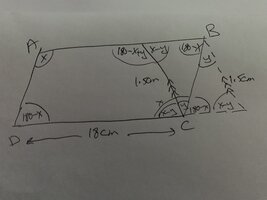You are using an out of date browser. It may not display this or other websites correctly.
You should upgrade or use an alternative browser.
You should upgrade or use an alternative browser.
How do I find the area of this parallelogram? (lateral side 9cm, bases 12cm, angle 73*)
- Thread starter chijioke
- Start date
Steven G
Elite Member
- Joined
- Dec 30, 2014
- Messages
- 14,383
Come on, you need to try something. Can you label the angles? Which ones are congruent?I continue. But what if I am given this parallelogramView attachment 35579
I would not know how to find the area because the height or included is is not given. Do you have any clue as to how to go about it?
Steven G
Elite Member
- Joined
- Dec 30, 2014
- Messages
- 14,383
Label that in your diagram. What do all the angles add up to? Are there any lines that you can draw to help?Angle DAB is congruent to angle DCB and angle ADC is congruent to angle ABC . So what next?
Steven G
Elite Member
- Joined
- Dec 30, 2014
- Messages
- 14,383
Great! Go for it.View attachment 35594
This is what I have for now. I can deduce anything concerning as to how get the height.
Do you know the sum of any other angles?
Have you tried using the side that measures 1.5cm.
Keep going you can do this or confirm that you can't find the area.
As it concerns the problem at hand. I don't.Great! Go for it.
Do you know the sum of any other angles?
I know that the area of a parallelogram is = base × height. But I am not seeing that side which measures as 1.5cm as the height.Have you tried using the side that measures 1.5cm.
If I want to try, I would say the area is [math]1. 5 cm × 18cm= 27 cm^2[/math] But I am doubting my solution because I am not sure if 1.5 cm is the height.Keep going you can do this or confirm that you can't find the area.
The Highlander
Full Member
- Joined
- Feb 18, 2022
- Messages
- 937
It can't be "\(\displaystyle 27 cm^2\)" or it would be a rectangle!If I want to try, I would say the area is [math]1. 5 cm × 18cm= 27 cm^2[/math] But I am doubting my solution because I am not sure if 1.5 cm is the height.
Last edited:
Yes. You are right! Thanks for coming to the rescue. It seems Steven G is no where to be found now.It can't be "\(\displaystyle 27 cm^2\)" or it would be a rectangle!
Last edited:
The Highlander
Full Member
- Joined
- Feb 18, 2022
- Messages
- 937
Like the Terminator, he will be back (when it suits him ?).Yes. You are right! Thanks for coming to the rescue. It seems Steven G is no where to be found now.
(As I suggested (in private) he may just be "teasing" the "correct" answer out of you;
@Steven G likes to make people work for their dinner. ?)
Last edited:
Steven G
Elite Member
- Joined
- Dec 30, 2014
- Messages
- 14,383
Of course you have to work for your dinner/solution.
I just want the student to know everything about the problem so they could find the are or conclude that there is no solution.
Yes, you do know the sum of two pair of angles. What is the sum and how does that help you?
I just want the student to know everything about the problem so they could find the are or conclude that there is no solution.
Yes, you do know the sum of two pair of angles. What is the sum and how does that help you?
Welcome back!
It doesn't help me in any way as long as the area of the parallelogram cannot be found with the given information.Yes, you do know the sum of two pair of angles. What is the sum and how does that help you.
The Highlander
Full Member
- Joined
- Feb 18, 2022
- Messages
- 937
The old blue meanie strikes again! ?
The INCOMPLETE image that has been posted above CANNOT be solved with the VISIBLE information.I continue. But what if I am given this parallelogramView attachment 35579
I would not know how to find the area because the height or included is is not given. Do you have any clue as to how to go about it?
That's another confirmation there.The INCOMPLETE image that has been posted above CANNOT be solved with the VISIBLE information.
The Highlander
Full Member
- Joined
- Feb 18, 2022
- Messages
- 937

